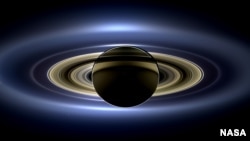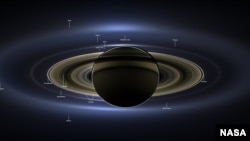If you were to travel to Saturn and look back toward Earth, this is what you would have seen this past July.
The U.S. space agency, NASA, just released a natural-color image of Saturn from space, the first in which Saturn, its moons and rings, and Earth, Venus and Mars, all are visible.
The image is actually a mosaic of 141 wide-angle photos taken by the Cassini probe. The image sweeps 404,880 miles (651,591 kilometers) across Saturn and its inner ring system, including all of Saturn's rings out to the E ring, which is Saturn's second outermost ring.
Earth is the bright blue dot to the lower right of Saturn. Venus is the bright dot to Saturn’s upper left. Mars also appears, as a faint red dot, above and to the left of Venus. Seven Saturnian moons are visible, including Enceladus on the left side of the image. Zooming into the image reveals the moon and the icy plume emanating from its south pole, supplying fine, powder-sized icy particles that make up the E ring.
"In this one magnificent view, Cassini has delivered to us a universe of marvels," said Carolyn Porco, Cassini's imaging team lead at the Space Science Institute in Boulder, Colorado.
Cassini does not attempt many images of Earth because the sun is so close to our planet that an unobstructed view would damage the spacecraft's sensitive detectors. Cassini team members looked for an opportunity when the sun would slip behind Saturn from Cassini's point of view. A good opportunity came on July 19, when Cassini was able to capture a picture of Earth and its moon, and this multi-image, backlit panorama of the Saturn system.
Launched in 1997, Cassini has explored the Saturn system for more than nine years. NASA plans to continue the mission through 2017.
The U.S. space agency, NASA, just released a natural-color image of Saturn from space, the first in which Saturn, its moons and rings, and Earth, Venus and Mars, all are visible.
The image is actually a mosaic of 141 wide-angle photos taken by the Cassini probe. The image sweeps 404,880 miles (651,591 kilometers) across Saturn and its inner ring system, including all of Saturn's rings out to the E ring, which is Saturn's second outermost ring.
Earth is the bright blue dot to the lower right of Saturn. Venus is the bright dot to Saturn’s upper left. Mars also appears, as a faint red dot, above and to the left of Venus. Seven Saturnian moons are visible, including Enceladus on the left side of the image. Zooming into the image reveals the moon and the icy plume emanating from its south pole, supplying fine, powder-sized icy particles that make up the E ring.
"In this one magnificent view, Cassini has delivered to us a universe of marvels," said Carolyn Porco, Cassini's imaging team lead at the Space Science Institute in Boulder, Colorado.
Cassini does not attempt many images of Earth because the sun is so close to our planet that an unobstructed view would damage the spacecraft's sensitive detectors. Cassini team members looked for an opportunity when the sun would slip behind Saturn from Cassini's point of view. A good opportunity came on July 19, when Cassini was able to capture a picture of Earth and its moon, and this multi-image, backlit panorama of the Saturn system.
Launched in 1997, Cassini has explored the Saturn system for more than nine years. NASA plans to continue the mission through 2017.

